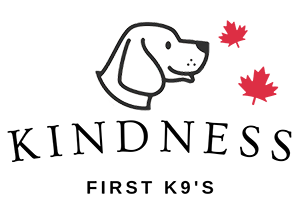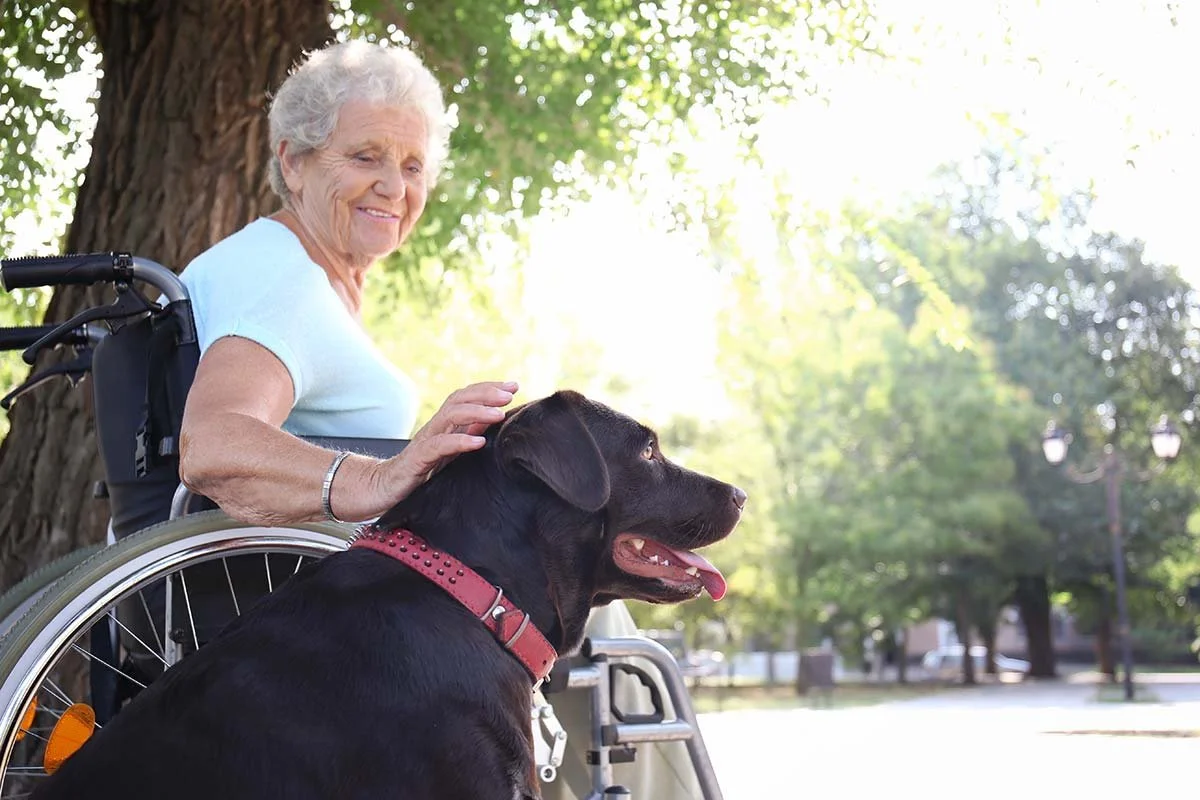Our Services
Train
We offer full training services. From the youngest puppies to teens to adults. We will custom tailor a program for you. Everything from Autism assistance, PTSD, TBI, and mobility assistance.
Mobile
Don’t have time to travel? No problem, we come to you. You and your dog can stay in the comfort of your own home. We are mobile and willing to travel all over the GTA and surrounding area.
Buy
Don’t have a dog? No problem. We are constantly training new puppies from the earliest age to be skilled service dogs capable of helping you and assisting in your day to day tasks.
Support
We offer a support program as well for any issues that may arise with your dog. We will make sure to resolve any issues with speed and confidence.
FAQs
-
Unfortunately it is up to the handler to stay up to date and consistent with training their new dog. We do however offer free in home sessions during the first month of owning your trained service dog in the case that you require additional education and tools for success. It is the client's responsibility to reach out immediately if behaviour changes or dog does not comply with basic obedience (as soon as it happens).
For prospect dogs, clients still have a month of free training and also have the responsibility of staying consistent and continuing training their prospect. They have the option of continuing their training with us through our owner assisted program.
-
I would like to acknowledge and validate the severity of anxiety disorders, recognizing that they can profoundly debilitate those who experience them. We hold reservations about training service dogs specifically for anxiety due to the attendant attention they attract, including unsolicited interactions and disruptions from strangers directed at the handler. While the prospect of mitigating a disability through a service dog is of significant benefit to many, it is important to acknowledge that certain individuals may weigh the advantages against the continuous demands of upkeep, training, and the daily life complexities linked to owning a working dog exposed to public settings. For instance, most - if not all- service dog handlers encounter challenging and distressing situations while attempting to access public venues such as taxis, eateries, and retail establishments. The presence of a service dog that does not conform to the historical archetype, such as the Labrador Retriever, might elicit concerns among private citizens, potentially disrupting both the dog's responsibilities and the handler's daily life. This could manifest as unwarranted attention through petting, calls, or conversations centered on the dog or canines in general.
Sustaining the dog's competence requires consistent training, often amounting to a minimum of one to two hours per week. Creating and upholding an environment conducive to the service dog's well-being presents a challenge for some, encompassing factors such as maintaining a clean living space, providing access to water, and allocating 30 minutes per day for off-leash exercise. It is worth noting that individuals contending with psychiatric disabilities might encounter difficulties in furnishing the stability and structure essential for a dog's healthy lifestyle. Given these concerns, my recommendation for individuals grappling with anxiety is to consider acquiring a companion animal and possibly obtaining a medical professional's endorsement certifying it as an emotional support animal. It's important to understand that an emotional support animal does NOT possess the same level of public access rights as a service dog and only assists the individual with anxiety by ensuring their right to have an animal in their residence, particularly within the context of Ontario's regulations.
(See/reference: https://capdt.ca/service-dogs/)
-
You need a disability confirmed by a qualified health professional and a note from them saying you require a service dog.
These documents can be either:
- Official papers from a regulated health professional (A doctor's note)
- An identification card from the Ontario Ministry of the Attorney General (for individuals who are visually impaired and use a guide dog)
Disabilities can come in various forms:
- They can be seen or invisible
- They might be present since birth
- They could develop gradually
- They might result from an accident
In Ontario, individuals with disabilities are protected by the following legislations:
1. **Blind Persons Rights Act**
(https://www.canlii.org/en/on/laws/stat/rso-1990-c-b7/latest/rso-1990-c-b7.html)
2. **Accessibility for Ontarians With Disabilities Act (AODA)**
3. **Human Rights Code**
(https://www.canlii.org/en/on/laws/stat/rso-1990-c-h19/latest/rso-1990-c-h19.html)
Please note that the above information is not intended as legal advice.
Additionally, you might find these resources valuable:
- **Ontario Accessibility Laws and Standards**
(https://www.ontario.ca/laws/regulation/110191#BK149)
*None of the above is intended as legal advice or a replacement for official laws.
- **What You Need to Know in Ontario**:
(https://www.ontario.ca/page/accessibility-ontario-what-you-need-to-know#section-7)
*None of the above is intended as legal advice or a replacement for official laws.
-
Within the Canadian context, the designation of a dog as a service dog or assistance dog is contingent upon specific criteria. A dog shall not be classified as such if:
-Its presence primarily serves protective purposes.
-Its presence is motivated by personal defense objectives.
-It is present to offer emotional comfort or assumes the role of an emotional support animal, unless it is engaged in mitigating a psychiatric disability substantiated by medical professional certification.
(Reference: https://capdt.ca/service-dogs/)**Please be aware that the term "Emotional Support Animal" (ESA) holds legal validity exclusively within the United States. Hence, if you are situated in Canada, refrain from paying for the registration of a dog as an ESA. Do not be scammed out of your money. Online service dog/ emotional support dog registries do not exist.
-The dog functions as a therapy animal, engaging in well-mannered interactions with individuals in settings such as hospitals or during personal counseling sessions.
-The dog operates as a facility or working dog, providing emotional solace in contexts like courtrooms or extending assistance to first responders. For instance, this encompasses facility dogs dedicated to aiding crime victims, search dogs, or cadaver dogs.
(See/reference: https://capdt.ca/service-dogs/)
-
Yes, businesses and public places in Ontario have the right to ask individuals with service dogs for documentation. This could be a prescription or a doctor's letter from a medical professional. Unfortunately, there are fake service animals out there, which creates issues for real service dog teams just trying to go about their daily lives.
However, if a business is in a location where the law doesn't allow service animals, they must provide another way for people with service dogs to access their goods or services.
-
A therapy dog is usually someone's pet that loves to meet different people in places like schools, nursing homes, or hospitals.
These dogs might or might not be trained, but they aren't trained for just one person or their specific needs. This sets them apart from service dogs.
Therapy dogs often go with their owners to different places, and many people benefit from these friendly dogs being around.
People in hospitals, schools, or other places feel better when they can pet, hold, or be near a calm and friendly animal.
But remember, therapy dogs don't have the same special rights as service dogs, even though they're still important.
-
Think about it - how are emotional support dogs trained? Simply put, they aren't. In the province of Ontario, emotional support animals (ESAs) are not recognized. There are no laws or extra housing rights for ESAs here.
In the United States, ESAs have housing rights, but not public access rights.
In Ontario, if you have a pet for emotional support, there's good news: landlords can't stop you from having a pet. This is stated in Section 14 of the Residential Tenancies Act. Also, landlords can't charge pet fees, and you can't be kicked out for having a pet. There are some limits on the types of pets allowed. Ontario landlords must accept all pets, which includes emotional support pets.
Unlike service animals, ESAs usually aren't trained for specific tasks. They might have basic dog training, but they don't perform special tasks for someone with a disability – their main role is just to be there and exist.
-
To begin service dog training, you'll need a note from a regulated health professional and have a disability. Any dog breed can be trained. We start with a temperament test to make sure they're suited for service work.
-
Yes, you can. We offer an owner-assisted program. Our trainers will help you train your dog to be the service dog you need.
-
They're trained to assist with disabilities, like tasks for autism, mobility, detecting seizures, heart rate changes, and more.
-
Yes, we provide service dog training, owner-training assistance for owners, and even occasionally have task-trained service dogs available. Contact us to find a good match for your needs.
-
Training can last up to 2.5 years. The cost varies based on factors like your needs, dog breed, and temperament. For precise details, contact us with you and your dog's circumstances.
-
Formal certification for service dogs isn't available in Ontario. To ensure your dog is well-mannered, it is recommended to pass The Canadian Canine Good Citizen test. This test ensures dogs behave properly at home, in public, around other dogs, and people. We've added extra requirements to our public access tests based on this template.
Please note: Our public access testing is exclusively offered to clients who have finished their training with us. Unfortunately, this service is not accessible to handlers who haven't undergone our training, including those who seek taking the test for flight documentation. We regret any inconvenience this may cause.
-
**Service Dog Tasks: Alerts**
- Alerting Family Members.
- Alerting to Crying/Calling/Yelling from Another Person or Child.
- Alerting for Help.
- Alerting to Alarms.
- Alerting to Allergens in Food.
- Alerting to Allergens in the Area.
- Alerting to Approaching Car.
- Alerting to Car Horn.
- Alerting to Dangerous Medical Levels (Blood Pressure, Cortisol, etc.).
- Alerting to Doorbell/Knocking.
- Alerting to Handler’s Name Being Called.
- Alerting to Person Coming Up Behind.
- Alerting to Phone.
- Alerting to Seizures.
- Alerting to Siren.
- Alerting to Sounds.
- Alerting to Unheard Dropped Item.
**Mobility and Stability Service Dog Tasks**
- Assist with Grounding.
- Assisting with Position Changes (e.g. Sitting to Standing).
- Assist with Transfers.
- Counter-Balance.
- Forward Momentum (in a wheelchair).
- Forward Momentum (when walking).
- Provide Momentum Up Inclines.
- Provide Momentum Up Stairs.
- Pull Handler with Strap (to change positions).
- Wheelchair Pulling.
- Answer the Door.
**Service Dog Tasks: Environmental Actions**
- Blocking Approaching Persons/Animals, etc.
- Blocking from Moving Towards Danger (busy road, away from home, etc).
- Call 911 on a Dog-Friendly Phone.
- Dial Pre-Programmed Number on a Dog-Friendly Phone.
- Call Suicide Hotline on a Dog-Friendly Phone.
- Carrying a Purse.
- Carrying Items Up or Down Stairs.
- Checking the House.
- Cleaning Up Items on the Floor (put in basket).
- Clearing a Room (enter ahead of the handler and check for intruders).
- Closing Washer/Dryer (with paw or nose).
- Closing Bathroom Stall Door.
- Closing Doors (pulling closed with a tug).
- Closing Doors (pushing closed with nose or paws).
- Dragging Heavy Items to Specific Location.
- Dragging a Laundry Basket.
- Finding a Bathroom.
- Finding Assigned Seat (e.g. at school, work, etc).
- Finding Elevator/Stairs/Escalator.
- Finding an Empty Seat.
- Finding the Car.
- Opening Sliding Door.
- Opening/Closing Cabinet/Drawer.
- Opening/Closing Dishwasher.
- Opening/Closing Refrigerator.
- Opening/Closing Bathroom Door.
- Opening Doors (handicapped button).
- Opening Doors (pulling open using a tug).
- Opening Doors (pushing open with nose or paws).
- Pull and Hold Heavy Door.
- Pulling Blankets Off/On.
- Pulling Blinds/Curtains Closed/Open.
- Pushing Floor Button to Turn on Lamp.
- Turning Off Lights (with paw, nose, or teeth).
- Turning On Lights (with paw, nose, or teeth).
- Unloading Items from the Washer or Dryer.
- Watching My Back.
**Interaction Service Dog Tasks**
- Bringing a Note to a Person.
- Crowd Control (circling).
- Delivering a Credit Card or Money to a Cashier.
- Delivering Items from Cashier to Handler.
- Delivering Item to Person.
- Finding a Specific Person.
- Following a Designated Person.
- Going to Find Help.
**Service Dog Tasks: Personal Actions**
- Cleaning Out a Person's Mouth (e.g. vomit, etc.).
- Covering.
- Interrupting Crying/Response.
- DPT (Deep Pressure Therapy).
- Finding Handler.
- Finding Disabled Handler (runners, wanderers, lost handler).
- Flashback Interruption.
- Helping Sit Up if Slumped Over.
- Helping with Turning Over.
- High Blood Sugar Alert.
- Interrupting Dissociation.
- Interrupting Freezing Behavior.
- Interrupting Harmful Behaviors.
- Interrupting Panic/Anxiety Attack.
- Interrupting Repetitive Behaviors.
- Interrupting Scratching/Skin Picking.
- Licking Face/Hands.
- Diabetic Alert.
- Medication Reminders.
- Nightmare Interruption.
- Panic/Anxiety Alert.
- Paws Up to Help with Putting on Dog Gear.
- Providing Distraction.
- Providing Excuse to Leave Uncomfortable Situation.
- Providing Pressure on the Chest to Produce Cough.
- Pushing Paralyzed Limb Back into Place.
- Removing Socks or Other Clothing.
- Responding to Anxious Behaviors.
- Rolling Handler onto Their Side (by nudging, pulling clothing).
- Routine Reminders (e.g. feed the dog, eat meals, go to sleep, etc).
- Tactile Stimulation.
- Waking Handler.
**Guiding Service Dog Tasks**
- Avoiding Moving Objects (while guiding).
- Guiding Home.
- Guiding to an Exit.
- Guiding to Specific Item.
- Guiding to Specific Location.
- Guiding to Specific Person.
- Guiding to a Safe Place.
- Indicating Barrier (while guiding).
- Indicating Curbs (while guiding).
- Indicating Drop-Offs (while guiding).
- Indicating Stairs/Steps (while guiding).
- Leading Around Ground Hazards (while guiding).
- Leading Around Low Hanging Items (while guiding).
- Leading Around Stationary Items (while guiding).
- Refusing to Move Forward if Not Safe.
**Service Dog Tasks: Retrieval**
- Retrieving Clothing Items (teach your dog to retrieve).
- Retrieving Dog Bowls.
- Retrieving Dropped Items.
- Retrieving Emergency Medication.
- Retrieving Items When Pointed To.
- Retrieving Juice/Gatorade/Etc.
- Retrieving Mobility Aid (e.g. Wheelchair, Cane, Walker, etc)
- Retrieving Named Items.
- Retrieving Phone.
- Retrieving Purse/Wallet.
- Retrieving Shoes.
- Retrieving Tissue (when crying, sneezing, coughing).
- Retrieving Towel (after a shower, bath).
- Retrieving Vest/Harness/Leash/Gear.
- Retrieving Water to Take Medication.
- Retrieving Item from Store Shelf.
-
Phone: 647-449-5359
Email: kindnessfirstk9s@gmail.com
“My life completely changed after my accident. I couldn’t imagine life without my service dog helping me everyday”
— OLIVIA, CLIENT





